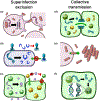Open questions in the social lives of viruses
- PMID: 37975507
- PMCID: PMC11281779
- DOI: 10.1111/jeb.14203
Open questions in the social lives of viruses
Abstract
Social interactions among viruses occur whenever multiple viral genomes infect the same cells, hosts, or populations of hosts. Viral social interactions range from cooperation to conflict, occur throughout the viral world, and affect every stage of the viral lifecycle. The ubiquity of these social interactions means that they can determine the population dynamics, evolutionary trajectory, and clinical progression of viral infections. At the same time, social interactions in viruses raise new questions for evolutionary theory, providing opportunities to test and extend existing frameworks within social evolution. Many opportunities exist at this interface: Insights into the evolution of viral social interactions have immediate implications for our understanding of the fundamental biology and clinical manifestation of viral diseases. However, these opportunities are currently limited because evolutionary biologists only rarely study social evolution in viruses. Here, we bridge this gap by (1) summarizing the ways in which viruses can interact socially, including consequences for social evolution and evolvability; (2) outlining some open questions raised by viruses that could challenge concepts within social evolution theory; and (3) providing some illustrative examples, data sources, and conceptual questions, for studying the natural history of social viruses.
Keywords: cheating; conflict; cooperation; evolutionary theory; natural history; population genetics, social evolution; virology; virus evolution.
© 2023 The Authors. Journal of Evolutionary Biology published by John Wiley & Sons Ltd on behalf of European Society for Evolutionary Biology.
Conflict of interest statement
CONFLICT OF INTEREST STATEMENT
No conflict of interest to declare.
Figures

Comment in
-
Bridging quasispecies theory and social evolution models for sociovirology insights: a commentary on Leeks et al. 2023.J Evol Biol. 2023 Nov;36(11):1590-1594. doi: 10.1111/jeb.14229. J Evol Biol. 2023. PMID: 37975502 No abstract available.
-
The social lives of viruses and other mobile genetic elements: a commentary on Leeks et al. 2023.J Evol Biol. 2023 Nov;36(11):1582-1586. doi: 10.1111/jeb.14239. J Evol Biol. 2023. PMID: 37975503 Free PMC article.
-
Multiple infection theory rather than 'socio-virology'? A commentary on Leeks et al. 2023.J Evol Biol. 2023 Nov;36(11):1571-1576. doi: 10.1111/jeb.14245. J Evol Biol. 2023. PMID: 37975504 No abstract available.
-
The social role of defective viral genomes in chronic viral infections: a commentary on Leeks et al. 2023.J Evol Biol. 2023 Nov;36(11):1577-1581. doi: 10.1111/jeb.14244. J Evol Biol. 2023. PMID: 37975505 Free PMC article. No abstract available.
-
The sociality continuum of viruses: a commentary on Leeks et al. 2023.J Evol Biol. 2023 Nov;36(11):1568-1570. doi: 10.1111/jeb.14247. J Evol Biol. 2023. PMID: 37975506 No abstract available.
-
Viruses, cancers, and evolutionary biology in the clinic: a commentary on Leeks et al. 2023.J Evol Biol. 2023 Nov;36(11):1587-1589. doi: 10.1111/jeb.14232. J Evol Biol. 2023. PMID: 37975508 No abstract available.
References
-
- Aaskov J, Buzacott K, Thu HM, Lowry K, & Holmes EC (2006). Long-term transmission of defective RNA viruses in humans and Aedes mosquitoes. Science, 311, 236–238. - PubMed
-
- Ågren JA, Davies NG, & Foster KR (2019). Enforcement is central to the evolution of cooperation. Nature Ecology & Evolution, 3, 1018–1029. - PubMed
Publication types
MeSH terms
Grants and funding
LinkOut - more resources
Full Text Sources
Medical
Miscellaneous

